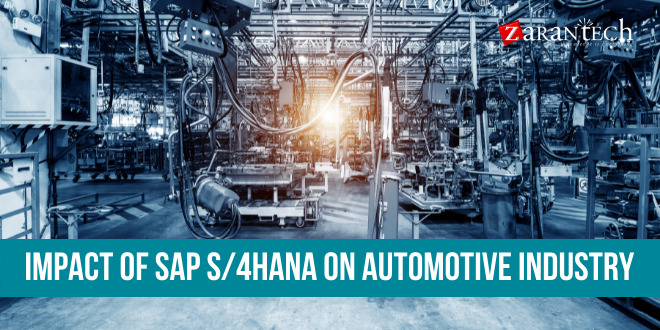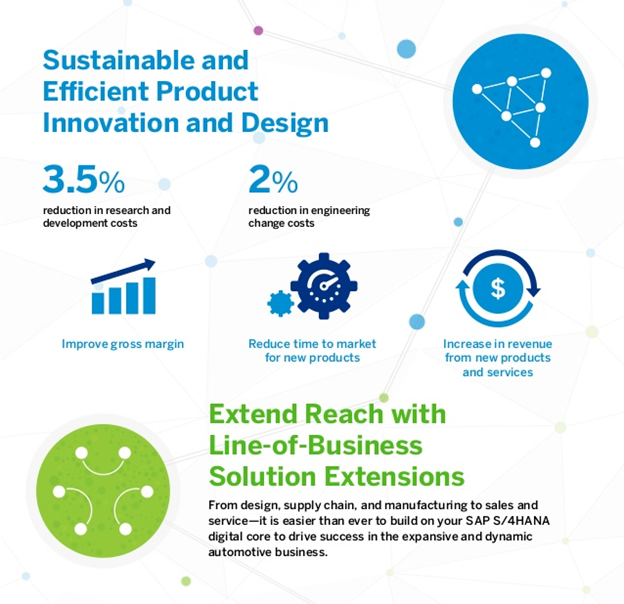Impact of SAP S/4HANA on Automotive Industry
Category: SAP S/4HANA Posted:Apr 25, 2018 By: Ashley Morrison The fourth technological revolution is the digital revolution. The evolution in digital technology has changed the business pattern of every industry. This is said by the founder of the World Economic Forum Klaus Schwab, who has related the merging of technologies in the physical, digital and biological spheres as the fourth iteration in the industry since the industrial revolution of the 18th century. The industry has to adopt new business practices as per the digital transformation. The companies adopting the best digital practices are having a competitive edge over those who have not adopted the digital technology. The automotive industry has been significantly transformed due to digital disruption. SAP S/4HANA is going to help the automotive industry in becoming digital. SAP S/4HANA is designed to form the foundation of the business going digital. It is built on advances in-memory platform, SAP HANA gives a customized user experience with SAP Fiori. This acts as the nerve center of the business as it integrates all the process of the business and provides an accurate analysis and projections of the business.
The fourth technological revolution is the digital revolution. The evolution in digital technology has changed the business pattern of every industry. This is said by the founder of the World Economic Forum Klaus Schwab, who has related the merging of technologies in the physical, digital and biological spheres as the fourth iteration in the industry since the industrial revolution of the 18th century. The industry has to adopt new business practices as per the digital transformation. The companies adopting the best digital practices are having a competitive edge over those who have not adopted the digital technology. The automotive industry has been significantly transformed due to digital disruption. SAP S/4HANA is going to help the automotive industry in becoming digital. SAP S/4HANA is designed to form the foundation of the business going digital. It is built on advances in-memory platform, SAP HANA gives a customized user experience with SAP Fiori. This acts as the nerve center of the business as it integrates all the process of the business and provides an accurate analysis and projections of the business.

Challenges faced by the Automotive Industry
The automotive industry is facing the biggest disruptions in technology after the industrial revolution. The digital age has brought new technology like artificial intelligence, machine learning, real-time computing, and changes in sensor technology, e-mobility, autonomous driving, and pay as you go service. The advancement in technology will reduce vehicular emissions. A report published in Mckinsey, shows that new technology is changing customer expectations for vehicles. The automotive industry will need to bring technological changes in hardware, software and alternative business models. The change in the technology that needs to bring in hardware includes enterprise connectivity, hardware, drive train and industrial design. Enterprise connectivity is connected to the business system such as fleet operations, transportation management. Hardware is about advanced sensors, etc. The Drivetrain includes electric motors and advanced batteries. Industrial designs are about the modular bodies, advanced user interface. Software changes that are to be incorporated include entertainment platform and autonomous drive. The customer wants entertainment features similar to home experience and want to have an option of the operating system with self-driving capacity. The customer expects apps and services that can be downloaded from the third party and company want data analytics that gives data feed to the manufacturers.

Priorities for Automotive Industry
In the digital age, the opportunity for the automotive industry is huge. However, the strategic priorities for the automotive industry are to build small products, digital supply chain, engage the changing workforce, customer first and new business models and mobility services.
- Build small products:
The company has been building products and bringing innovations in design where sensors and software can be embedded while improving the overall product lifecycle.
- Digital Supply Chain:
The supply chain has to be integrated from the suppliers to the customer. The integration of the entire process helps in predicting the fluctuations in supply and demand. It also facilitates inventory management.
- Engaging a changing workforce:
The type of workforce has changed in the digital world. The millennial wants engaging, experience, and skilled work instead of boring repetitive jobs. The digital technology has increased the demand for smarter products which require skills in software development, machine learning, artificial intelligence, etc.
- Customer Centricity:
Market forces and change in technology has brought the customer in the middle of the product development cycle. Now the products are prepared to meet the expectations of the customer. There is a need for a continuous feedback mechanism. The good customer experience builds loyalty helps in customer retention and predicts the customer interests.
- New business models and mobility services:
It is predicted that by 2030, 22% of automotive revenue shall come from transportation as a service, shared mobility and other digital services related to automotive. The suppliers, dealers, aftermarket retailers are utilizing new technologies to open new business models and finding new possibilities for monetizing the services.
The big question for the automotive industry is finding the ways to achieve these priorities.This can happen by bringing digital innovation in business models, processes, products and customer engagement. SAP S/4HANA is designed to assist the company in achieving these five priority areas for the automotive industry. It achieves these priorities by integrating the five pillars of digital strategy. The innovation has been brought in the SAP portfolio to provide stable digital core facilities and flexible line-of-business extensions. The emphasis is on to cover the entire digital transformation right from the planning a digital innovation, implanting those plans with industry best practices and efficiently utilizing the resources for various deployment purposes. SAP S/4HANA has simplified the business process and providing key industry capabilities such as sustainable product innovation, manufacturing and logistics, responsive supply chain, marketing, sales and after sales, and finally smart mobility and transportation.
Sustainable Innovation Product
1. The typical challenge faced by automotive sector is their inability to bring customer-driven product offerings to market timely. This leads to low brand equity and slow growth. SAP S/4HANA solves this problem by searchable development history to increase reuse or decrease the time and investment in developments which were not leading to results.
2. The other area of concern was that the automotive industry was unable to identify the reasons for unsuccessful product initiatives. The product life cycle tool enables removing out of unprofitable product configurations.
3. There were inefficiencies in results as there were several heterogeneous platforms for engineering and manufacturing builds. The solutions offered are the enterprise product engineering with SAP Fiori. It maintains multiple Bills of Material in a personalized user interface with enhanced analytics.
4. The handling of the configuration model is complex and costly. The multidisciplinary approach was challenging labor-intensive and erroneous. But the optimization of low-level configuration in the context of materials requirement planning simplifies variant management.
5. The team was unable to use the software component of the vehicle during the development stage. The new SAP Fiori app provides 360-degree product views, including electronic,mechanical, software simulations,etc.
6. The benefits of moving to SAP S/4HANA platforms are an increase in revenue from 0.2%-0.4% of new products and services. The time for entering of new products to market from assembly line is reduced. There is an improvement in gross margin. The research and development expenses, optimize to 2.9%-3.6%. The engineering change cost reduced to 1.8% -2.3%.
Manufacturing and Logistics
1. There were planning inefficiencies due to long and overnight batch runs. The inability to include real-time, changing demands leads to inaccurate planning. SAP S/4HANA offers live MRP. The improved MRP runs are 10 times faster and run multiple times a day.
2. The system locking behaviors leads to delayed material postings. The distributed systems lead to inaccurate stock reporting. There is now the facility of real-time inventory management and materials valuation. The data model is simplified, “principle of one” valuation, SAP Fiori apps for warehouse clerks and inventory managers.
3. There were difficulties in filling customer orders on time with a proper quantity in the near time horizon. SAP HANA databases enabled mass product availability check for sales, planned, and production orders.
4. The higher cost of ownership available to promise functionality in ERP. This requires the use of supplemental software products. The digital core of SAP S/4HANA ERP and planning functions are available in the same system and the same database.
5. There were overhead costs of managing a separate set of shop floor across multiple plants which were not integrated into enterprise planning and business. The combination of SAP S/4HANA, SAP Manufacturing Integration and Intelligence (SAP MII), and SAP Manufacturing Execution offers an end-to-end process integration.
6. These innovative developments improve the manufacturing and logistics segment of the automotive industry.The manufacturing cycle time reduced to 4.5%-5.6%. The manufacturing planning and function, efficiency improved. The inventory time is reduced to 6.8%-8.5%.There is a reduction in the lead time, safety stock inventory, revenue loss due to fulfillment issues, order lost, manufacturing technology cost and manufacturing overhead costs.
Responsive Supply Networks
1. The supply networks need to be automated and robust. The priority is to track digital components, actualize efficient replenishment strategies and enable 3D printing for spare parts.
2. The aim is to achieve real-time, end-to-end visibility into supply chain management. It requires simulation scenarios in real-time and actions are to be recommended.
3. The supply networks have to establish key metrics to help manage by exception and focus on problems.
4. They have to deliver on-time and advance availability-to-promise capabilities. There is a need for collaboration between customers and suppliers. The demand sensing is to be improved and automate replenishment. The logistics performance and service parts planning are to be optimized.
5. SAP S/4HANA provides global traceability of the supply networks. The entire business planning has been integrated and transportation management. There is a facility of collaborative supply chain and efficient planning related to service parts. The application, like advanced available to promise boosted the efficiency of supply networks. There is also inventory and basic warehouse management.
Marketing, Sales and Aftermark
1. The lack of visibility into the order management process leads to slow resolution of the order fulfillment process and delayed the risk of delivery. The new sales order monitors and prepare a prioritized list with an outstanding order based on real-time analytics. SAP S/4HANA gives insights and collaborated internal sales professional.
2. There was a lack of transparencies in order-to-cash performance due to difficulties in monitoring order-to-cash performance.
3. The embedded analytics in SAP S/4HANA help the sales manager to analyze performance trends.
4. The general users struggle with the complexities of the user interface for the comprehensive process and sometimes missed simplified search capabilities. SAP HANA allows end users to do the full-text searching for business documents and provides results ranking along with business criteria.
5. There were difficulties of selling low-availability products. The advanced ATP helps the user with new strategies for high volume, backorder processing and confirmation on business priority.
6. The handling of rebate processing was complex. The new business models were based on flexible contracts. There is a central contract administration with a single point of entry of contract data and contract-related conditions.
7. The systemic changes brought by adopting these measures brought several benefits. There is an increase in on time delivery, reduced sales costs to 3.8%-4.7%. The increasing order management FTE productivity 1.8%-2.0%. The source of these data is SAP Value Assurance data for Automotive. The order-to-cash costs decreased and performance efficiency increased. The sales quotation productivity increases and reduces sales training costs. The number of sales transactions increased and reduces sales rebate overpayments.
Digital Services
1. The availability of digital services created a feedback loop in the internal business process. It created a vehicle network to connect digital products in the field.
2. The digital services give full visibility of the vehicle and part life cycle. The parts can be produced with 3D printing. It helps in simplifying and accessing information in real time across business domains.
3. The digital services lead to performance based services and products as a service. It monitors remote conditions and performance. It innovates digital service, billing and revenue management and embedded software management.
Conclusion: Value creation for Automotive Industry
SAP S/4HANA is helping the automotive companies to accelerate innovation in the product, improving the quality, reducing manufacturing costs, and sells and services vehicles more profitably. It provides data driven technology that blend together the world of sensors, technology and vehicle data with a world of application and practices. It increases the market share in a highly competitive market. SAP delivers services that satisfy customers and meet regulatory requirements. It empowers industry to manufacture cost-efficient vehicles by adopting automotive best practices. It optimizes efficiency, reduces the cost and uncertainty in global supply networks. The customer satisfaction and retention have been increased with a positive buying experience. It facilitates different business models in the digital economy. SAP S/4HANA provides a cutting-edge solution for the automotive industry that gives them a competitive edge over others. It helps in achieving company manufacturing, sales and marketing goals easily. The increased equipment effectiveness reduces manufacturing costs and faster delivery of products to market. The predictive models help in real time prediction with advanced analytics and bring excellence in sales and services. As per SAP Performance benchmarking there is a 15% reduction in manufacturing costs where machinery and tools are allocated to operations and status and usage are tracked in real time. There is a reduction in 13% cost per interaction where multichannel is used for customer contact. SAP S/4HANA gives solution formed the foundation of enterprises that drive performance and gives a competitive edge. It offers the benefits of industry-specific solutions on-premise, in the cloud and via mobile devices.
Got any questions for us? Please mention it in the comments section and we will return it to you. At ZaranTech we offer a self-paced online training program for S4 HANA. Skyrocket your career by learning from the best!
You can also visit our website for more engaging and informative articles.





 99999999 (Toll Free)
99999999 (Toll Free)  +91 9999999
+91 9999999